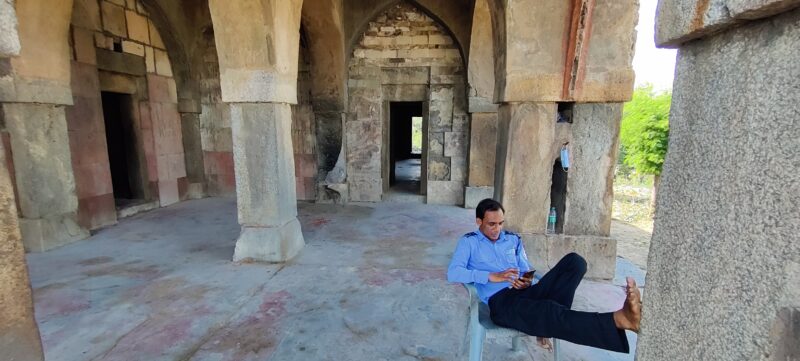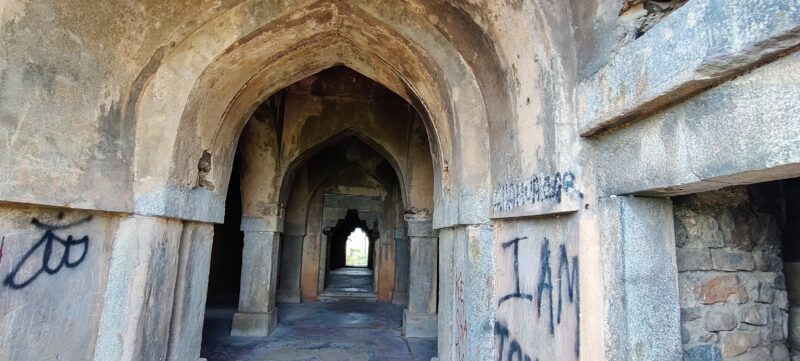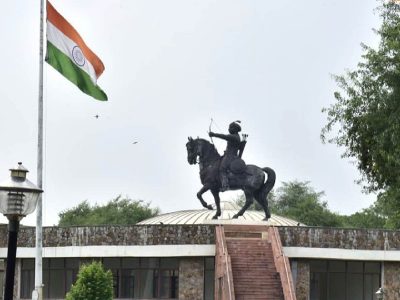In the heart of New Delhi’s bustling Chanakyapuri, amid the cacophony, stands a silent sentinel to history — the 14th-century Malcha Mahal, a hunting lodge built during the reign of Firoz Shah Tughlaq.
This architectural marvel, once the abode of self-proclaimed descendant of the royal family of Awadh, has now become a haunting enigma with its grandeur slowly fading into the quietude of the surrounding forest.
Decay and Neglect
When Patriot visited the monument, a scene of neglect and decay met the eye. The once-majestic structure, witness to centuries gone by, now stands dilapidated, with several parts sustaining heavy damage due to neglect. Trees have pushed through its stairs and windows, and one section of the complex has collapsed entirely. Deep cracks mar its pillars and neglect is further accentuated by graffiti covering its grand walls, testament to the intrusion of curious visitors.


Amid this decay, a tragic tale unfolds. In 2017, Prince Ali Raza, the last of the family that once inhabited Malcha Mahal, was found dead within its walls, adding to the mystique surrounding this historical gem. Despite its dilapidated state, Malcha Mahal has become a sanctuary for thrill-seekers and curious souls. As night falls, it comes alive with those brave enough to explore its haunted legacy.
A Haven for Garbage and Stray Animals
Surrounding the outskirts of the palace, heaps of garbage mingle with remnants of human activity — expired medicine, liquor bottles, and polythene bags, painting a grim picture of disregard for the monument’s historical significance.

The wildlife of the forest also makes its presence felt. Jackals and monkeys roam freely, adapting to the neglect by scavenging among the debris. Some visitors, undeterred by the decay, engage with the wildlife, feeding the monkeys.
A Tale of Hope
The Delhi government has tried to capitalise on the monument’s spooky atmosphere, launching “haunted” heritage walks around the structure from May 7.

On September 4, the Delhi High Court directed that construction activities be stopped within the Central Ridge area of the national capital, including plans for a 25-metre boundary wall, grill work, and visitors’ toilets at the historic monument, Malcha Mahal.
This interim order came in response to a contempt plea, wherein advocates Gautam Narayan and Aditya N Prasad raised issues related to tree plantation directions in the national capital. The court recognised the importance of preserving the monument and emphasised that construction within the Central Ridge, including the proposed boundary wall and toilets, should not proceed at this time.

Justice Jasmeet Singh emphasised that the Central Ridge serves as a protected area, providing fresh air and acting as a natural barrier to the hot winds blowing from Rajasthan into the national capital. As a result, the court ruled that no concretisation should take place within the area at this time.

An official from the Department of Archaeology told Patriot that plans are in motion to enhance amenities for tourists, although the number of visitors remains limited.
Currently, entry is free until a boundary wall is constructed, emphasising the cautious approach being taken to preserve this historical marvel.
A Beacon of Delhi’s Rich History
In the quietude of the forest, where legends intertwine with reality, Malcha Mahal stands as a testament to Delhi’s rich and mysterious past. It continues to beckon the brave-hearted, offering a journey into the depths of history and the enigmatic lives that once inhabited its walls. Malcha Mahal, despite its crumbling facade, awaits those daring enough to explore its haunted legacy, promising to unveil its secrets to those who venture within.




